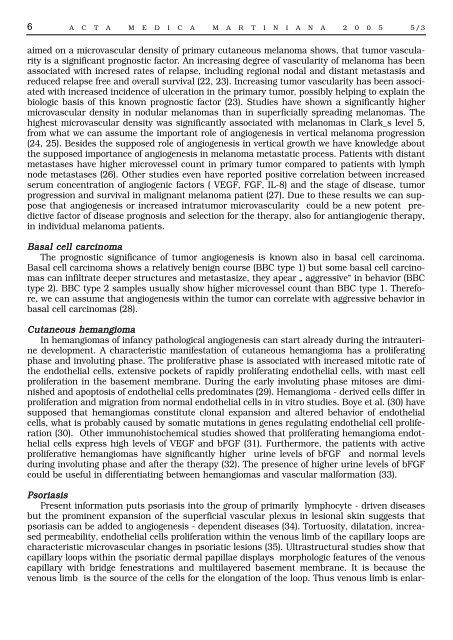MAKETA 5/3
MAKETA 5/3
MAKETA 5/3
You also want an ePaper? Increase the reach of your titles
YUMPU automatically turns print PDFs into web optimized ePapers that Google loves.
6<br />
A C T A M E D I C A M A R T I N I A N A 2 0 0 5 5/3<br />
aimed on a microvascular density of primary cutaneous melanoma shows, that tumor vascularity<br />
is a significant prognostic factor. An increasing degree of vascularity of melanoma has been<br />
associated with incresed rates of relapse, including regional nodal and distant metastasis and<br />
reduced relapse free and overall survival (22, 23). Increasing tumor vascularity has been associated<br />
with increased incidence of ulceration in the primary tumor, possibly helping to explain the<br />
biologic basis of this known prognostic factor (23). Studies have shown a significantly higher<br />
microvascular density in nodular melanomas than in superficially spreading melanomas. The<br />
highest microvascular density was significantly associated with melanomas in Clark_s level 5,<br />
from what we can assume the important role of angiogenesis in vertical melanoma progression<br />
(24, 25). Besides the supposed role of angiogenesis in vertical growth we have knowledge about<br />
the supposed importance of angiogenesis in melanoma metastatic process. Patients with distant<br />
metastases have higher microvessel count in primary tumor compared to patients with lymph<br />
node metastases (26). Other studies even have reported positive correlation between increased<br />
serum concentration of angiogenic factors ( VEGF, FGF, IL-8) and the stage of disease, tumor<br />
progression and survival in malignant melanoma patient (27). Due to these results we can suppose<br />
that angiogenesis or increased intratumor microvascularity could be a new potent predictive<br />
factor of disease prognosis and selection for the therapy, also for antiangiogenic therapy,<br />
in individual melanoma patients.<br />
Basal cell carcinoma<br />
The prognostic significance of tumor angiogenesis is known also in basal cell carcinoma.<br />
Basal cell carcinoma shows a relatively benign course (BBC type 1) but some basal cell carcinomas<br />
can infiltrate deeper structures and metastasize, they apear „ aggressive“ in behavior (BBC<br />
type 2). BBC type 2 samples usually show higher microvessel count than BBC type 1. Therefore,<br />
we can assume that angiogenesis within the tumor can correlate with aggressive behavior in<br />
basal cell carcinomas (28).<br />
Cutaneous hemangioma<br />
In hemangiomas of infancy pathological angiogenesis can start already during the intrauterine<br />
development. A characteristic manifestation of cutaneous hemangioma has a proliferating<br />
phase and involuting phase. The proliferative phase is associated with increased mitotic rate of<br />
the endothelial cells, extensive pockets of rapidly proliferating endothelial cells, with mast cell<br />
proliferation in the basement membrane. During the early involuting phase mitoses are diminished<br />
and apoptosis of endothelial cells predominates (29). Hemangioma - derived cells differ in<br />
proliferation and migration from normal endothelial cells in in vitro studies. Boye et al. (30) have<br />
supposed that hemangiomas constitute clonal expansion and altered behavior of endothelial<br />
cells, what is probably caused by somatic mutations in genes regulating endothelial cell proliferation<br />
(30). Other immunohistochemical studies showed that proliferating hemangioma endothelial<br />
cells express high levels of VEGF and bFGF (31). Furthermore, the patients with active<br />
proliferative hemangiomas have significantly higher urine levels of bFGF and normal levels<br />
during involuting phase and after the therapy (32). The presence of higher urine levels of bFGF<br />
could be useful in differentiating between hemangiomas and vascular malformation (33).<br />
Psoriasis<br />
Present information puts psoriasis into the group of primarily lymphocyte - driven diseases<br />
but the prominent expansion of the superficial vascular plexus in lesional skin suggests that<br />
psoriasis can be added to angiogenesis - dependent diseases (34). Tortuosity, dilatation, increased<br />
permeability, endothelial cells proliferation within the venous limb of the capillary loops are<br />
characteristic microvascular changes in psoriatic lesions (35). Ultrastructural studies show that<br />
capillary loops within the psoriatic dermal papillae displays morphologic features of the venous<br />
capillary with bridge fenestrations and multilayered basement membrane. It is because the<br />
venous limb is the source of the cells for the elongation of the loop. Thus venous limb is enlar-
















